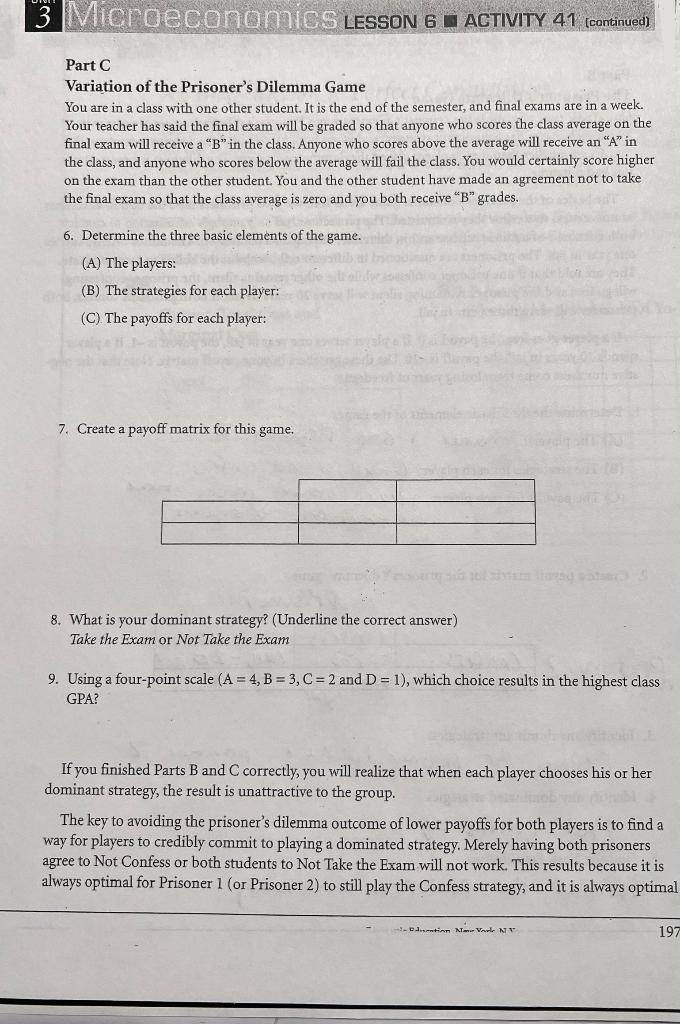
3 Microeconomics LESSON 6 ACTIVITY 41 [continued) Part Variation of the Prisoner's Dilemma Game You are in a class with one other student. It is the end of the semester, and final exams are in a week. Your teacher has said the final exam will be graded so that anyone who scores the class average on the final exam will receive a "B" in the class. Anyone who scores above the average will receive an "A" in the class, and anyone who scores below the average will fail the class. You would certainly score higher on the exam than the other student. You and the other student have made an agreement not to take the final exam so that the class average is zero and you both receive B grades. 6. Determine the three basic elements of the game. (A) The players: (B) The strategies for each player: (C). The payoffs for each player: 7. Create a payoff matrix for this game. 8. What is your dominant strategy? (Underline the correct answer) Take the Exam or Not Take the Exam 9. Using a four-point scale (A = 4, B = 3, C = 2 and D = 1), which choice results in the highest class GPA? If you finished Parts B and C correctly, you will realize that when each player chooses his or her dominant strategy, the result is unattractive to the group. The key to avoiding the prisoner's dilemma outcome of lower payoffs for both players is to find a way for players to credibly commit to playing a dominated strategy. Merely having both prisoners agree to Not Confess or both students to Not Take the Exam will not work. This results because it is always optimal for Prisoner 1 (or Prisoner 2) to still play the Confess strategy, and it is always optimal Dentin Vad NT 197 3 Microeconomics LESSON 6 ACTIVITY 41 [continued) Part Variation of the Prisoner's Dilemma Game You are in a class with one other student. It is the end of the semester, and final exams are in a week. Your teacher has said the final exam will be graded so that anyone who scores the class average on the final exam will receive a "B" in the class. Anyone who scores above the average will receive an "A" in the class, and anyone who scores below the average will fail the class. You would certainly score higher on the exam than the other student. You and the other student have made an agreement not to take the final exam so that the class average is zero and you both receive B grades. 6. Determine the three basic elements of the game. (A) The players: (B) The strategies for each player: (C). The payoffs for each player: 7. Create a payoff matrix for this game. 8. What is your dominant strategy? (Underline the correct answer) Take the Exam or Not Take the Exam 9. Using a four-point scale (A = 4, B = 3, C = 2 and D = 1), which choice results in the highest class GPA? If you finished Parts B and C correctly, you will realize that when each player chooses his or her dominant strategy, the result is unattractive to the group. The key to avoiding the prisoner's dilemma outcome of lower payoffs for both players is to find a way for players to credibly commit to playing a dominated strategy. Merely having both prisoners agree to Not Confess or both students to Not Take the Exam will not work. This results because it is always optimal for Prisoner 1 (or Prisoner 2) to still play the Confess strategy, and it is always optimal Dentin Vad NT 197







